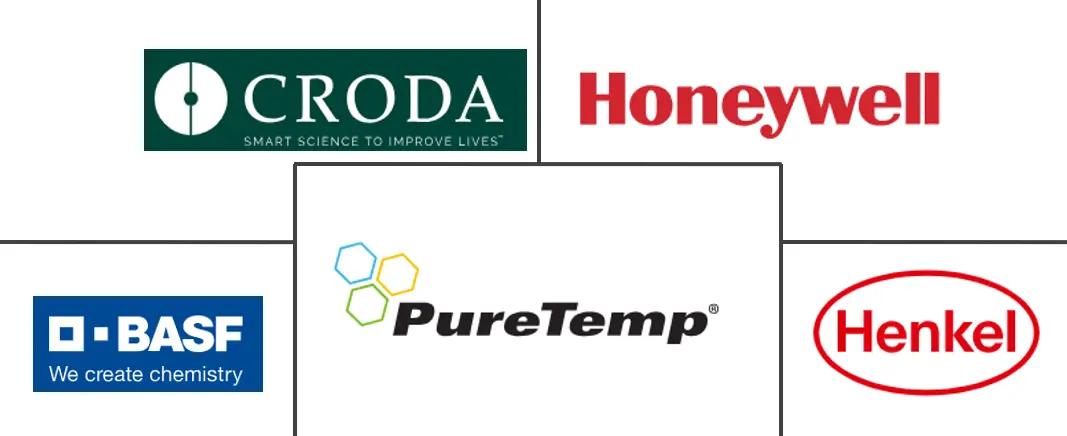Phase Change Materials Market Size and Share
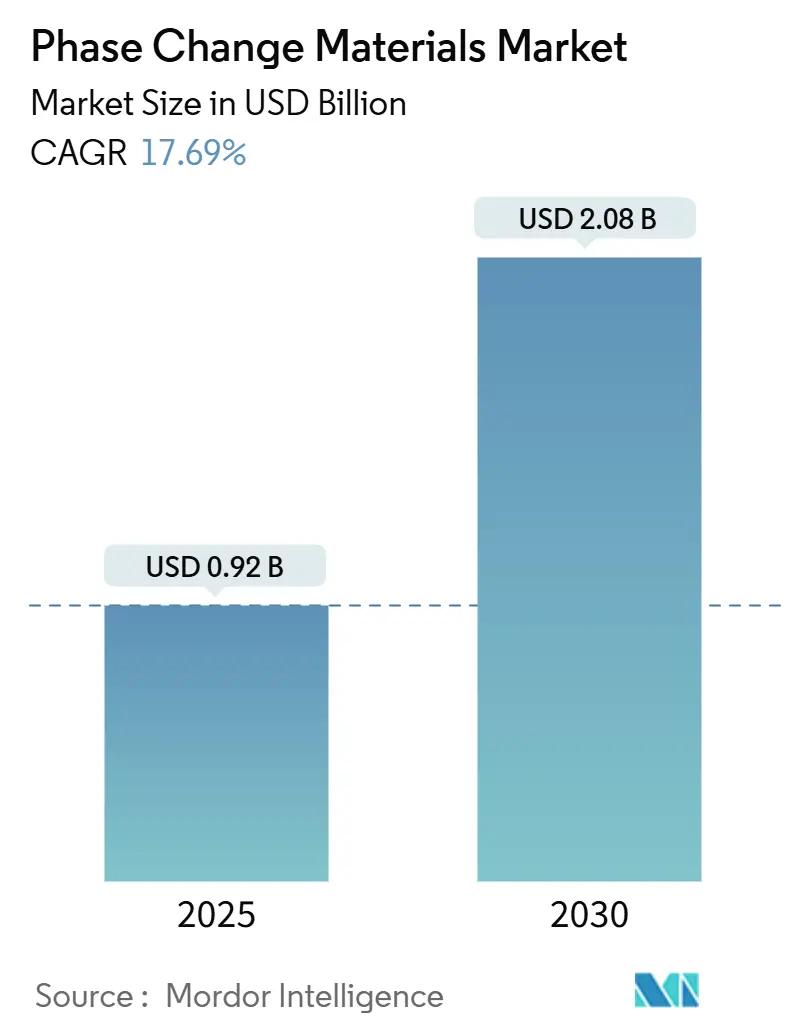
Phase Change Materials Market Analysis by Mordor Intelligence
The Phase Change Materials Market size is estimated at USD 0.92 billion in 2025, and is expected to reach USD 2.08 billion by 2030, at a CAGR of 17.69% during the forecast period (2025-2030). Lengthening heat waves, net-zero construction goals, and rapid electrification in transport now place latent-heat storage at the center of commercial energy strategies. Mandatory building-energy codes in Europe and North America are accelerating integration, while cold-chain logistics and electric-vehicle battery packs expand the technology’s reach into transportation, pharmaceuticals, and data-center cooling. Longly constrained by phase-separation and supercooling issues, salt hydrates are gaining traction after recent conductivity breakthroughs. At the same time, bio-based PCMs derived from agricultural residues have moved from laboratory curiosity to scalable commercial products, addressing fire safety and sustainability concerns without sacrificing thermal capacity. Regionally, Asia-Pacific is evolving into the fulcrum for capacity additions as manufacturers add local production lines to hedge supply-chain risk linked to high-purity salt hydrates.
Key Report Takeaways
- By product type, organic PCMs led with 44.19% Phase Change Material market share in 2024; bio-based materials are forecast to expand at a 19.21% CAGR through 2030.
- By chemical composition, paraffin-based solutions held the largest revenue share at 41.49% in 2024, while salt hydrates are advancing at an 18.04% CAGR to 2030.
- By encapsulation technology, the macro-encapsulation segment captured 65.95% of the Phase Change Material market size in 2024; micro-encapsulation is expected to grow at 18.74% CAGR between 2025-2030.
- By end-user industry, the building and construction segment commanded 39.66% share of the Phase Change Material market size in 2024 and is projected to sustain an 18.17% CAGR through 2030.
- By geography, Europe contributed 32.86% of global revenue in 2024, whereas Asia-Pacific is forecast to record the quickest regional pace at 18.98% CAGR to 2030.
Global Phase Change Materials Market Trends and Insights
Driver Impact Analysis
| Drivers | (~) % Impact on CAGR Forecast | Geographic Relevance | Peak Impact |
|---|---|---|---|
| Mandatory Building-Energy Codes in Europe and North America Accelerating PCM Integration | +3.2% | Europe, North America | Medium term (~ 3-4 yrs) |
| Rapid Deployment of Cold-Chain Logistics Infrastructure | +2.8% | Global, with emphasis on Asia-Pacific | Short term (≤ 2 yrs) |
| Electrification of Vehicles Necessitating Advanced Thermal Battery Packs Using Salt-Hydrate PCMs | +4.5% | North America, Europe, China | Medium term (~ 3-4 yrs) |
| Government Incentives for Net-Zero Buildings Propelling Bio-based PCM Adoption | +3.9% | Europe, North America, and developed Asia-Pacific | Long term (≥ 5 yrs) |
| Expanding Global Trend Towards Energy Conservation and Sustainable Development | +3.1% | Global | Long term (≥ 5 yrs) |
| Source: Mordor Intelligence | |||
Mandatory Building-Energy Codes Accelerating PCM Integration
Performance-based compliance criteria now allow architects to substitute rigid insulation with latent-heat storage layers, unlocking a 35-45% reduction in peak cooling loads within lightweight walls. Measured field results in Minnesota reported a 5.49 °C drop in peak indoor temperature plus a 77.8% load shift toward off-peak hours, providing regulators with real-world evidence of HVAC savings[1]Minnesota Department of Commerce, “Field Study of Phase Change Material (PCM) Use for Passive Thermal Management,” mn.gov. Rising compliance thresholds for 2027 EU renovation targets are expected to place additional emphasis on PCM-infused gypsum boards and concrete blocks, thereby lifting procurement volumes across the Phase Change Material market.
Rapid Deployment of Cold-Chain Logistics Infrastructure
Vaccines, advanced biologics, and precision meats require temperature bands that often tolerate a ±0.5 °C deviation for less than three days. PCMs extend that holdover to 72 hours without external power, cutting diesel-generator reliance during airport or customs delays. Glycerol-water-NaCl blends slash carbon footprints 30-40% versus active cooling and lift pharmaceutical shelf life by 15-25%, feeding double-digit demand across the Phase Change Material market.
Electrification of Vehicles Necessitating Advanced Thermal Battery Packs
Composite salt-hydrate matrices disperse heat spikes generated under 4C discharge, maintaining cell temperatures below 39 °C and curbing thermal-runaway risk. Compared with forced-air convection, PCM plates shrink peak temperatures by up to 40% and lengthen battery longevity, a decisive factor as EV warranties stretch toward 10 years. Tier-1 suppliers are scaling graphite-reinforced pads that align with cylindrical, pouch, and prismatic cell formats, further broadening the Phase Change Material market.
Government Incentives for Net-Zero Buildings Propelling Bio-Based PCM Adoption
Bio-derived latent-heat blends sourced from plant oils, animal fats, and agricultural residues secure additional points under LEED v4 and BREEAM 2025. Bacon-fat PCMs now deliver 2.36 × the thermal-storage density of standard paraffin at a lower cost. Financial offsets, such as Germany’s BEG program covering 20% of building envelope upgrades, are triggering higher order volumes, especially as bio-PCMs exhibit reduced smoke and toxicity profiles versus petroleum alternatives.
Restraint Impact Analysis
| Restraints | (~) % Impact on CAGR Forecast | Geographic Relevance | Peak Impact |
|---|---|---|---|
| Hazardous Nature of Phase Change Materials | -2.1% | Global, with higher impact in regions with strict chemical regulations | Short term (≤ 2 yrs) |
| Supply-Chain Volatility of High-Purity Salt Hydrates | -3.4% | Global, with particular impact on Asia-Pacific manufacturing | Medium term (~ 3-4 yrs) |
| Limited Awareness and Understanding | -1.8% | Emerging markets, particularly in South America and parts of Asia | Short term (≤ 2 yrs) |
| Source: Mordor Intelligence | |||
Hazardous Nature of Phase Change Materials
Paraffin waxes ignite at roughly 170 °C and require brominated flame retardants that add cost and can trigger health-labeling restrictions. Inorganic candidates such as LiNO₃ present toxicity risks. Recent in-situ polymerized solid-solid PCMs eliminate leakage, passing UL94 V-0 flammability without halogens. Broader adoption hinges on scaling these encapsulation advances and harmonizing global chemical safety standards.
Supply-Chain Volatility of High-Purity Salt Hydrates
Medical-grade CaCl₂·6H₂O relies on narrow mining zones and multistage purification, whose capacity additions lag demand. Spot shortages have driven 2024 contract prices, pressuring producers that depend on micro-encapsulation lines calibrated for consistent crystal purity. Graphite-reinforced composites that tolerate industrial-grade inputs while maintaining 4 W/m·K conductivity offer a mid-term safeguard. Nevertheless, any raw-material squeeze reverberates through the Phase Change Material market value chain.
Segment Analysis
By Product Type: Bio-Based Solutions Accelerate Market Diversification
Organic paraffin waxes remain the revenue anchor for the Phase Change Material market, accounting for 44.19% of global sales in 2024. Their dominance reflects mature supply chains, broad temperature coverage, and compatibility with macro-encapsulation slabs used in building panels. Yet the Phase Change Material market is witnessing a sharp pivot toward bio-derived oils, tallow, and fatty-acid blends as stakeholders chase lower life-cycle emissions. The emergent sub-segment is forecast to outpace all others at 19.21% CAGR to 2030, buoyed by LEED credits and municipal green-procurement mandates that explicitly endorse biogenic materials.
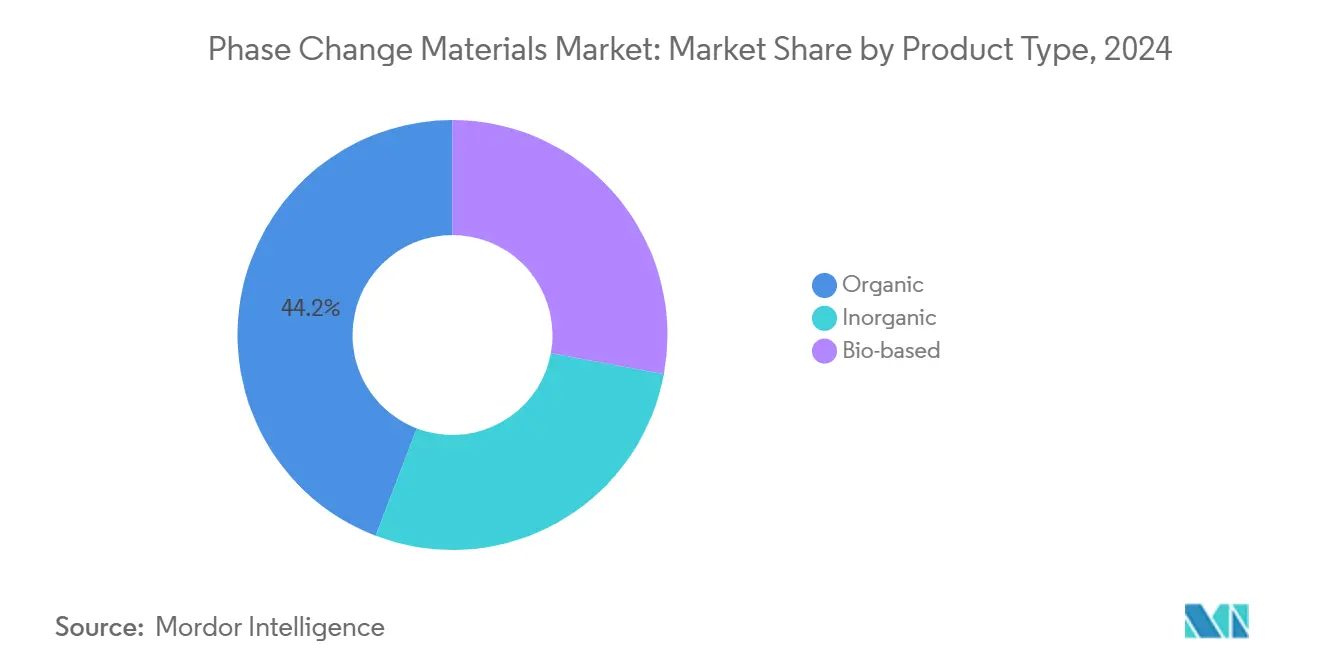
Note: Segment shares of all individual segments available upon report purchase
By Chemical Composition: Salt Hydrates Challenge Paraffin Dominance
Paraffin-based formulations captured 41.49% of the Phase Change Material market revenue in 2024 due to their stable crystallization and ease of tailoring melting points across the 0-90 °C spectrum. Even so, salt hydrates are on course to disrupt that hierarchy, expanding at an 18.04% CAGR through 2030. High volumetric heat capacity (up to 350 kJ/L) and thermal conductivity improvements via carbon additives are allowing salt hydrates to shrink component size and weight. The resulting density advantage is especially attractive for electric-vehicle battery sleeves and compact data-center racks, where available footprint is constrained.
By Encapsulation Technology: Micro-Encapsulation Reinvents Performance Boundaries
Macro-encapsulation, drums, panels, and tubes currently safeguard 65.95% of the Phase Change Material market size, thanks to straightforward manufacturing and installation within gypsum boards, ceiling tiles, and chilled-water tanks. However, micro-encapsulation is accelerating at an 18.74% CAGR, fueled by the need for leakage-proof dispersions that can be sprayed, printed, or woven into fabrics. Capsules coated with graphene oxide now exhibit conductivity gains topping 1008% over neat paraffin, enabling faster charge–discharge cycles crucial for peak-shaving applications.
By End-User Industry: Building and Construction Remains the Anchor
The construction sector consumed 39.66% of global PCM volumes 2024 by retrofitting walls, roofs, and concrete blocks with latent heat inserts that shave 20-35% off HVAC energy demand, meeting European Energy Performance directives. Regional demonstration buildings in Spain, Sweden, and Germany show that PCM-enhanced wallboards can sustain a 5.49 °C delta for half an hour under simulated solar load. These replicable metrics justify line-item allocations in large public-sector renovation budgets, anchoring the Phase Change Material market.
The transportation category is surging due to electric-vehicle pack adoption, hybrid railcars, and refrigerated shipping containers. PCM liners now push lithium-ion cell temperatures 40% lower than natural convection equivalents, extending cycle life and improving fast-charge tolerance. Packaging follows closely, as pharmaceutical distributors prepare for ever stricter GDP (Good Distribution Practice) rules that clamp down on temperature excursions. Once limited to comfort clothing, textiles now employ PCM microcapsules in military uniforms and medical wraps for localized cooling or controlled drug release, further widening the Phase Change Material industry scope.
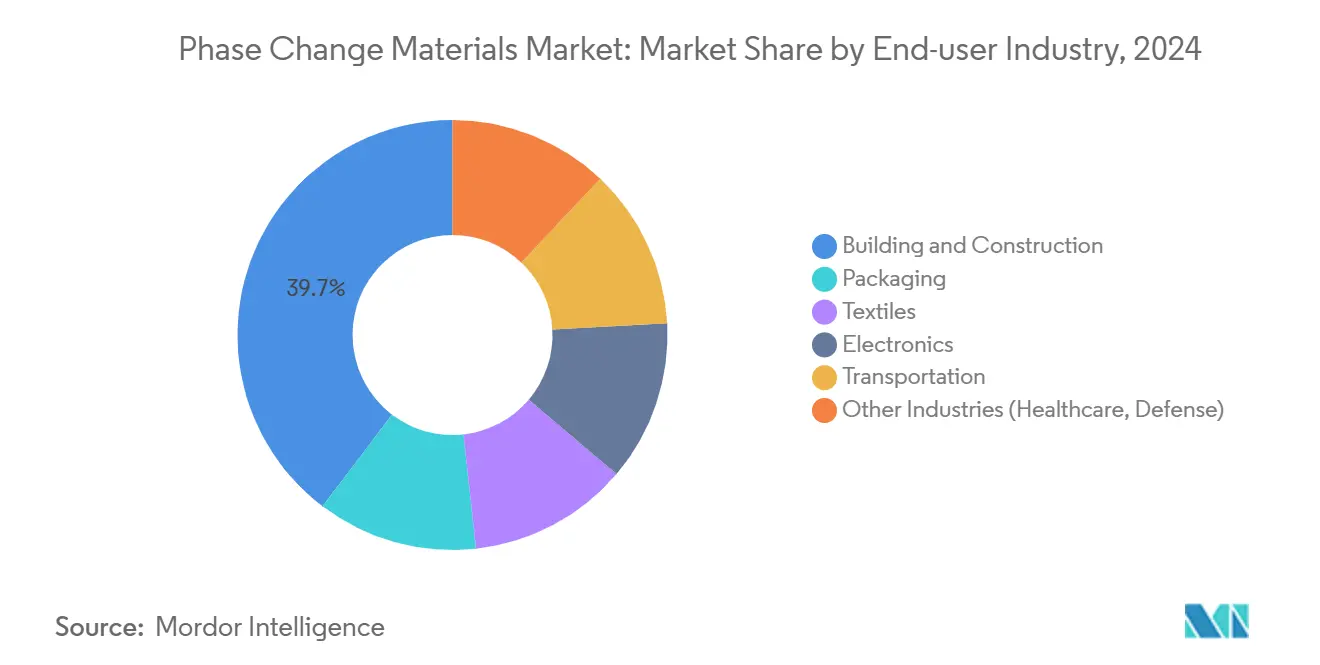
Note: Segment shares of all individual segments available upon report purchase
Geography Analysis
Europe held 32.86% of global sales in 2024, underpinned by the EU’s Energy Performance of Buildings Directive, which compels both new construction and deep-renovation projects to hit quasi-net-zero targets. Early adopters in Germany and the Nordics have shown 20-35% HVAC energy savings after embedding PCMs into external wall insulation systems. Regulatory clarity around carbon trading and green-bond eligibility continues to draw capital toward PCM-rich building materials, consolidating Europe’s leadership position in the Phase Change Material market.
Asia-Pacific is the fastest-growing region, anticipated to expand 18.98% annually through 2030. China’s aggressive heat-pump rollout complements PCM thermal storage by shaving peak electricity demand, a synergy encouraged under the “Future of Heat Pumps” roadmap[2]International Energy Agency, “The Future of Heat Pumps in China,” iea.org .
North America combines stringent energy-code updates with an exploding electric-vehicle sector. Data-center operators in the United States, drawn by tax credits for on-site energy storage, pilot PCM-based thermal buffers to absorb server heat spikes and postpone chiller start-up.
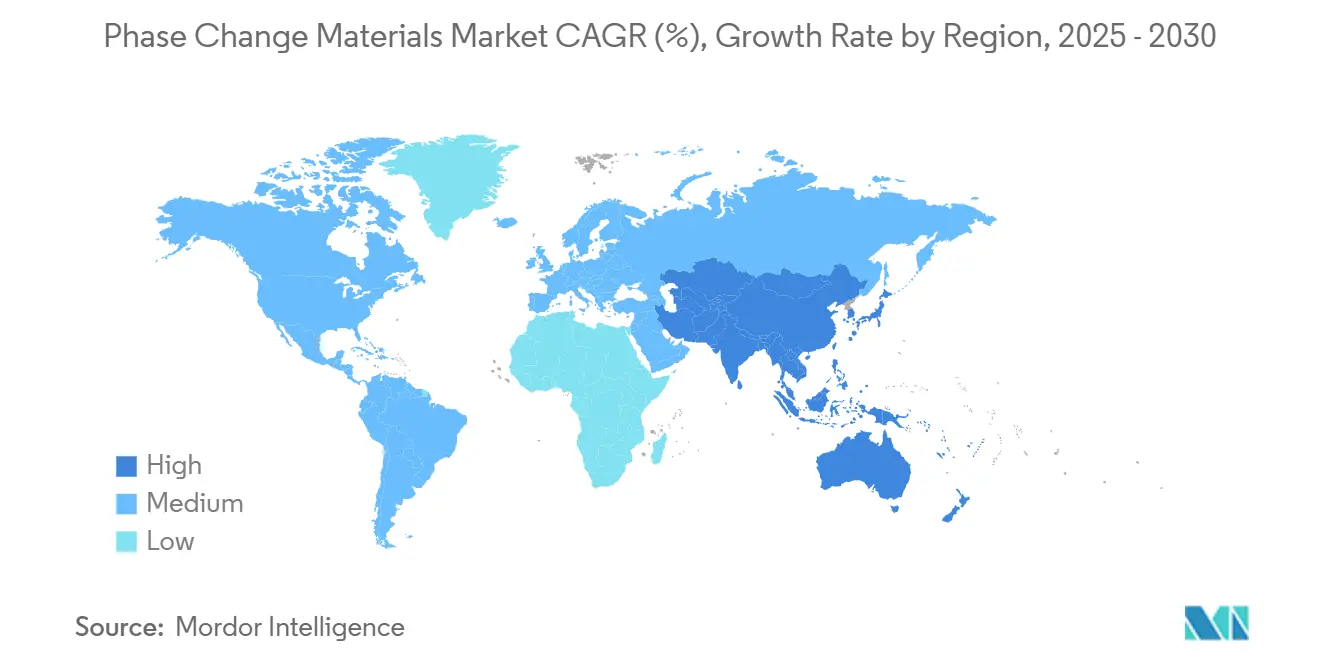
Competitive Landscape
The Phase Change Material market is highly fragmented, with a long tail of regional specialists competing alongside diversified multinationals. Phase Change Solutions has capitalized on vertical integration, coupling feedstock sourcing with in-house encapsulation and downstream system design, a model that compresses lead times for OEM customers. Innovation remains the chief competitive lever. High-purity salt-hydrate supply is another front; several Asia-Pacific manufacturers negotiate off-take agreements with mining firms to secure stable crystal supply, mitigating volatility that could crimp margins.
Phase Change Materials Industry Leaders
-
BASF
-
Croda International Plc
-
Henkel AG & Co. KGaA
-
Honeywell International Inc.
-
PureTemp LLC
- *Disclaimer: Major Players sorted in no particular order

Recent Industry Developments
- August 2024: Pluss Advanced Technology launched Form-Stable PCM at LogiPharma 2024 in Lyon. The organic 2 °C-8 °C blend broadens pharmaceutical-logistics options by eliminating leakage risk while meeting WHO stability criteria.
- March 2023: Phase Change Solutions expanded its portfolio with shape-stable BioPCM Bricks. The extruded BioPCM Brick is reusable, durable, and retains its shape up to +60⁰C.
Global Phase Change Materials Market Report Scope
A phase change material is a substance that releases/absorbs sufficient energy at phase transition to provide helpful heat/cooling. PCMs can provide district cooling and thermal buffer swings in buildings and store solar thermal energy for short-term or seasonal applications. The market is segmented by product type, encapsulation technology, end-user industry, and geography. By product type, the market is segmented into organic, inorganic, and bio-based products. Regarding encapsulation technology, the market is segmented into macro, micro, and molecular. End-user industry segmentation includes building and construction, packaging, textiles, electronics, transportation, and other end-user industries. The report also covers the market size and forecasts in 14 countries across major regions. The report offers market size and forecasts for phase change materials in terms of revenue (USD million) for all the above segments.
| Organic |
| Inorganic |
| Bio-based |
| Paraffin |
| Non-Paraffin Hydrocarbons |
| Salt Hydrates |
| Eutectics |
| Macro-encapsulation |
| Micro-encapsulation |
| Molecular Encapsulation |
| Building and Construction |
| Packaging |
| Textiles |
| Electronics |
| Transportation |
| Other Industries (Healthcare, Defense) |
| Asia-Pacific | China |
| India | |
| Japan | |
| South Korea | |
| Rest of Asia-Pacific | |
| North America | United States |
| Canada | |
| Mexico | |
| Europe | Germany |
| United Kingdom | |
| France | |
| Italy | |
| Rest of Europe | |
| South America | Brazil |
| Argentina | |
| Rest of South America | |
| Middle-East and Africa | Saudi Arabia |
| South Africa | |
| Rest of Middle-East and Africa |
| By Product Type | Organic | |
| Inorganic | ||
| Bio-based | ||
| By Chemical Composition | Paraffin | |
| Non-Paraffin Hydrocarbons | ||
| Salt Hydrates | ||
| Eutectics | ||
| By Encapsulation Technology | Macro-encapsulation | |
| Micro-encapsulation | ||
| Molecular Encapsulation | ||
| By End-user Industry | Building and Construction | |
| Packaging | ||
| Textiles | ||
| Electronics | ||
| Transportation | ||
| Other Industries (Healthcare, Defense) | ||
| By Geography | Asia-Pacific | China |
| India | ||
| Japan | ||
| South Korea | ||
| Rest of Asia-Pacific | ||
| North America | United States | |
| Canada | ||
| Mexico | ||
| Europe | Germany | |
| United Kingdom | ||
| France | ||
| Italy | ||
| Rest of Europe | ||
| South America | Brazil | |
| Argentina | ||
| Rest of South America | ||
| Middle-East and Africa | Saudi Arabia | |
| South Africa | ||
| Rest of Middle-East and Africa | ||
Key Questions Answered in the Report
What is driving the rapid growth of the Phase Change Material market?
Demand stems from stricter building-energy codes, cold-chain logistics expansion, and electric-vehicle battery cooling, pushing the Phase Change Material market size toward USD 2.08 billion by 2030.
Which product segment is growing the fastest?
Bio-based PCMs, derived from renewable oils and fats, are expected to post a 19.21% CAGR, outpacing all other categories within the Phase Change Material market.
How do salt-hydrate PCMs compare with paraffin waxes?
Salt hydrates offer higher volumetric heat capacity and better thermal conductivity, and their share of the Phase Change Material market is advancing at 18.04% CAGR as supercooling challenges are resolved.
Why are micro-encapsulated PCMs gaining popularity?
Micro-capsules prevent leakage, improve mechanical strength, and integrate easily into paints or fabrics; this sub-segment is growing at 18.74% CAGR, the quickest among encapsulation methods.
Which region offers the highest growth potential?
Asia-Pacific is projected to expand at an 18.98% CAGR due to large-scale construction, logistics investments, and aggressive electrification programs that collectively broaden the Phase Change Material market.
Page last updated on:
